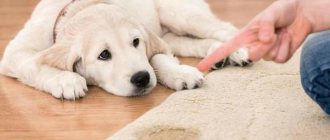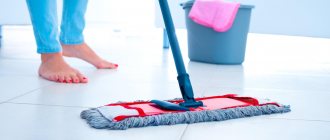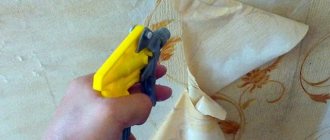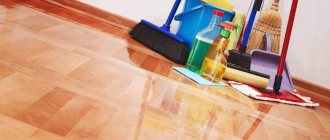We understand the seriousness of the situation with COVID-19, the lack of specialized disinfectants and antiseptics, and masks in the pharmacy, so we have prepared a number of articles on how to deal with the virus in conditions of shortage - it’s free. In our store all disinfectants are in stock and at low prices.
The threat of infection with the new dangerous virus Covid-19 has forced many to take much more careful care of cleanliness and safety in their homes, apartments, and businesses. Many people replenished their stocks of antibacterial disinfectants from pharmacies, replacing their usual household chemicals. The basis of disinfectants is alcohol, 70% vodka, bleach. Auxiliary components include iodine, hydrogen peroxide, antifungal mixtures, antibacterial liquids, essential oils. What antiseptics are best to disinfect a house, apartment, office, and how to do it correctly, we will tell you further.
How does standard apartment cleaning differ from disinfection?
What the housewife does every day is the usual cleaning procedures designed to remove dust and dirt from surfaces, deposits on ceramics and faucets, and sand on the floor. Cleansing is fundamentally different from disinfection, without which, in a global pandemic, it is impossible to feel protected, even if not 100%.
Disinfect means using special safe antibacterial and antiviral agents containing substances that destroy most pathogens from viruses and bacteria to fungi.
The virucidal activity of antiseptics for house cleaning lies in the ability to destroy the protein shells of viruses, thereby disrupting their vital processes and ability to reproduce. If the disinfectant also contains antibacterial and antifungal components, the protection is enhanced and the home interior becomes safe.
Types of materials for processing and protection
The following materials are usually used for processing wooden floors:
- an antiseptic is necessary for all wood products to protect against damage by microorganisms;
- varnishes increase the wear resistance and strength of the surface, protect from moisture;
- oils are worth choosing if you want to protect the floor from absorbing dirt, improve its aesthetic characteristics, and protect it from moisture and damage by microorganisms;
- after treatment with oils or antiseptic impregnations, wax is often applied; it adds shine to the surface, eliminates minor irregularities and defects, and protects against moisture and damage by microorganisms;
- if you want to cover the surface with a dense color composition, then choose paint; under a thick layer of paint, the board is reliably protected from moisture, sun and other negative influences.
Antiseptic impregnations
Primary treatment with antiseptic impregnations is carried out at the stage of lumber procurement. After this, during the operation of the finished product, this treatment is periodically repeated to extend the service life.
Materials for waterproofing wooden floors and installation technology
An antiseptic for wooden floors is needed both for preventive purposes and for visible damage to the wood by mold and bacteria. The following types of impregnations are used:
- Water-soluble compositions are characterized by their absence of odor, rapid absorption and ease of application (even a damp surface can be treated). The compositions are absolutely non-toxic. They are used in residential and commercial buildings for processing doors, frames, fences and other lumber. The disadvantages include the following:
- water-based antiseptics are not suitable for boards in contact with water;
- penetrate shallowly.
- Organic-based mixtures are characterized by deep penetration. They contain many useful additives. But they have a pungent odor and require preliminary surface preparation before application. Used in damp rooms, for example, cellars or baths.
- Combination products are also available for sale.
Important! All antiseptics are divided into transport ones, which are intended for temporary treatment of wood during its transportation and installation, and long-term ones, intended to protect the product for many decades.
Lucky
This transparent product, after being applied to the surface and drying, forms a durable transparent film that gives the product shine, increases the wear resistance of the floor, and protects against moisture, rot and mold.
Varnishes are produced on the basis of different resins, which are dissolved by volatile compounds. Acrylic copolymers, polyurethane, synthetic and natural resins are used as a base.
The following types of varnishes are used to treat wooden surfaces:
- Water-soluble one- and two-component compositions. The most durable and expensive two-component varnishes. They are characterized by their absence of odor and drying speed. Such varnishes increase the wear resistance of the floor.
- Alkyd compositions emphasize the natural beauty of wood and increase the strength of the product. They are not suitable for high temperature environments, are difficult to apply and take a long time to dry.
- Polyurethane-based mixtures are the strongest and most durable. After their application, the wear resistance of the floor increases significantly. The disadvantage of these compounds is that they are applied only to well-dried boards. Otherwise, defects appear on the surface in the form of swellings and bubbles.
Dye
This opaque durable coating is made on the basis of acrylic, polyurethane or vinyl tetrachloride. Most often, alkyd and acrylic paints are used in homes, which have the following advantages:
- they are very easy and simple to apply;
- the floor surface is easy to care for;
- do not need to use special cleaning products;
- every consumer can choose an affordable product;
- a large selection of colors, which makes it easier to select a coating to match the color of the interior;
- The paint layer, provided proper care and gentle mechanical stress, will last for many years.
Important! The disadvantage of paint is the low aesthetic appeal of the coating compared to varnish, oil and wax. Moreover, the paint hides the beauty of the wood, and the coating loses its natural appearance.
Oil impregnations
Oil impregnation for wooden floors differs from varnish in that it does not form a dense, impenetrable layer on the surface. The oil is absorbed into the upper layers of wood and increases the moisture resistance of the material and its resistance to wear.
If you have wooden floors in your nursery, it’s not difficult to guess how to treat their surface if you study all the features of oil impregnation. Oil fills all the pores of wood and reduces the possibility of penetration of moisture and dirt. But at the same time, the natural appearance of the material and the beauty of its texture are completely preserved.
Leveling a wooden floor: technology and necessary materials
Important! There are colorless oils that preserve the natural color of the material, and compositions that give the product a certain shade.
Oil impregnations allow you to obtain a pleasant-to-touch, non-slip surface. This covering option is suitable for living rooms with low traffic, for example, bedrooms and children's rooms. But keep in mind that oil treatment will have to be renewed periodically.
Wax
There are special waxes on sale for impregnating wood. They are applied to the surface using special rollers, after which they are thoroughly rubbed and sanded with a soft cloth. Waxing is needed to increase the moisture resistance of the floor, giving it beauty and a beautiful shade.
Important! The main disadvantage of wax is its low resistance to mechanical stress.
However, wax coating is ideal for floors with defects such as small cracks, crevices and uneven surfaces, as once applied, all these problems are eliminated. The result is an even, smooth and shiny surface.
How to properly disinfect an apartment, office, industrial premises of enterprises?
When disinfecting an apartment, house, or business, there are several rules regarding the cleaning of rooms and surfaces for different purposes. The frequency of disinfection measures depends on how strictly family members observe quarantine, whether they go to work or do not leave home, and whether there is a person among them with illness or symptoms of respiratory diseases.
Recommendations on how to properly disinfect an apartment.
- Several times a day, disinfect those surfaces in the room that most people come into contact with. These are door handles, table surfaces, toilet (toilet lid and cistern), toilet paper holder, switches.
- Wet mop and clean the floor 1-2 times a day, more often in the children's room, especially if there are small children crawling and playing on the floor.
- In the bedroom and kitchen, the handles of dressers, drawers and cabinets, the door and the handle of the refrigerator must be disinfected.
- Remove trash from your home trash can every day and periodically disinfect it with antibacterial disinfection.
- Disinfect faucets in the bathroom and kitchen several times a day, preferably after each use or after returning home from outside.
- Pay special attention to the TV remote; for easy cleaning, it is placed in a case.
- In each room, clean the walls, ceiling, and doorway in a manner that is suitable for the existing surfaces.
- Sponges, rags, floor rags, reusable wipes used for disinfection should not be used for other purposes.
- Store everything used for cleaning in a separate container and soak in solutions after each cleaning.
- Carry out disinfecting cleaning wearing gloves also intended for the intended use.
- After cleaning, ventilate the apartment or house well to reduce the concentration of harmful fumes.
Disinfecting disinfection is always preceded by the classic cleaning of surfaces in the house and apartment from dust and dirt, and washing the floors.
Cleaning and disinfection of office, public premises and enterprises includes 3 stages.
- Cleaning the premises from visible contaminants.
- Sanitary cleaning and treatment of certain areas of the premises.
- Disinfection of all surfaces, including floors, walls, doors, equipment.
For effective cleaning and antiseptic treatment of premises, enterprises and offices use automated systems in combination with manual labor. Office equipment and enterprise equipment are treated with special care using special means. Screens, keyboards, faxes, telephones are wiped with napkins and rags soaked in disinfectant solutions. It is important to clean and disinfect the ventilation system.
Disinfecting the floor in an apartment using a vacuum cleaner
Whatever the manufacturers of modern vacuum cleaners say about the effectiveness of their products in terms of combating dust mites and other microorganisms, this is all nothing more than a publicity stunt. Yes, vacuum cleaners (especially those with innovative air filtration systems) quite effectively remove small debris and some dust from the floor. But they inevitably lift more of it into the air (alas). And this cannot be prevented either by increasing the suction power or in any other way, since weightless dust rises upward with the mere approach of the nozzle moving over the carpet.
Therefore, after a carpeted or carpeted floor has been cleaned with a vacuum cleaner, to disinfect the floors in the room, it is imperative to wet clean the floor surface that is not covered with carpets.
Types of disinfectants by composition and purpose
The most popular and widely used in households, businesses and offices are safe disinfectants based on alcohol and chlorine. The best antiseptic should contain 70% alcohol (ethanol, propanol) or 56% active chlorine. Both types of products are effective against most pathogens and protect by 95% or more. But they cannot be used safely on all types of home surfaces and premises.
Thus, alcohol-containing ones are ideal for treating the skin of hands, plastics, metal products (door handles), chipboard, MDF, and stone. Metal products cannot be disinfected with chlorine-containing products, since chlorine causes corrosion of metal and is also unsafe for hands.
Ideally, both types of products should be used to disinfect the premises of a house or apartment. This increases the degree of protection against viruses and bacteria and allows you to competently treat surfaces of various purposes and origins.
Keep in mind that chlorine has an unpleasant odor that slowly evaporates, but surfaces treated with it in a house or apartment remain sterile and safe for a long time. Alcohol also has an odor, but it evaporates from the premises in a short time, and along with this the high degree of protection disappears.
Review and effectiveness of traditional methods of safe disinfection
The flooring is varied: wood, stone, marble, linoleum. Each type needs a specific cleaning agent. You can wash the floors at home using a budget option (folk methods) or disinfectant solutions of household chemicals.
Common methods of treating floors:
- greasy stains in the room will be removed by shaving foam. Apply a small amount of foam to the contaminated area, let stand for a couple of minutes, rinse with water;
- Ammonia will get rid of dirt and unpleasant odors. Take 1⁄3 bottles into a bucket of water and wash the surfaces with the solution. It is recommended to use ethyl alcohol for disinfection. Modern materials do not stand up to experimentation. In order not to disturb the integrity and color of the floors, use proven cleaning methods. The combination of alcohol and bleach has a detrimental effect on the appearance;
- To make the house smell, scent the rooms. Essential oils (lavender, pine needles, fir) disinfect the air and envelop the apartment with a pleasant smell. Clean floors and aromatherapy will give you warmth and tranquility;
- To clean and disinfect the surface, use a vinegar solution (one glass of acetic acid per 5 liters of water). The product is perfect for linoleum, ceramic tiles, and vinyl flooring. Use vinegar liquid on wooden floors with caution. The wood is covered with wax, paint, varnish or oil. Vinegar removes wax. It’s worth trying the method on an inconspicuous area to find out if the substance is suitable for cleaning. Acetic acid is contraindicated for marble and granite floors. It destroys the integrity of the stone. Essential oils can help reduce the smell of vinegar. After drying, there will be no trace of the smell;
- add a few drops of vegetable oil to make the floor shine. A caveat: with each cleaning, oil accumulates, do not overuse it;
- linseed oil cleans linoleum efficiently. Mix with vinegar 1:1. Rub the mixture onto the surface and leave to dry. If there are abrasions or unclear marks, wipe them thoroughly before rubbing in the prepared solution;
- Apple cider vinegar will get rid of stains and remove plaque. The gentle action will help clean different types of coating;
- Hard water leaves mineral deposits on the surface. Use an effective recipe: 2 tablespoons of baking soda per 5 liters of detergent;
- Housewives polish linoleum with vinegar after washing: add 6 tbsp to a five-liter bucket. l vinegar and 4 tbsp furniture polish. Mix the ingredients, wash the surfaces;
- All kinds of stains can be removed using regular powder. Sprinkle the powder onto the stain, drop lemon juice or citric acid on it, and add water. Leave for a couple of minutes.
Affordable products are at hand, no need to spend money on household chemicals. Traditional methods of disinfecting floors are not inferior to store-bought ones. Effectively destroy bacteria, viruses, remove stains, remove stains.
Floor cleaning products
It is better to disinfect the floor with liquid concentrates containing chlorine. They are safe and easy to use, as they are diluted in water and perfectly disinfect the surface. There are a huge number of such items among industrial household chemicals; you can choose and buy them with any scent and concentration of active chlorine in a pharmacy or store. Effective disinfectant options:
- Septolite Light;
- Proklin Oldey;
- Demos.
The main thing is to remember that floor disinfection is the final stage of the overall treatment of the house. It is preceded by sanitary cleaning of tiles and plumbing fixtures in the bathroom and toilet, also with chlorine-containing compounds. The priority is gels or sprays, wipes for door handles.
Disinfection of metal surfaces (including door handles)
To treat metal surfaces, alcohol-containing or oxygen-containing compounds are used. They do not affect the metal surface, but cope well with pathogenic organisms.
The priority is alcohol-containing disinfectants for apartments and houses - sprays or wipes that have high virucidal activity. Here is a list of safe and effective disinfectants for cleaning the house according to user reviews:
- Septolite Tetra;
- Aquaminol spray;
- Lavoll.
Disinfection of home furniture and air
For antiseptic care of furniture, gentle compositions with caring components are used: polishes, oils, ammonia, etc. It is safe to carry out antiseptic cleaning for most surfaces with such means as:
- Proklin Oldey;
- Remedin spray;
- Eco Breeze (napkins).
To safely disinfect the air at home, use a 70% ethyl alcohol solution. Disinfection is carried out by spraying from a spray bottle; all surfaces in the apartment are additionally treated. It's good if you have an air purifier at home. It serves as additional protection. Absolute medical alcohol 96% from a pharmacy cannot be used as an antiseptic. Ethanol works more effectively in combination with water.
Types of flooring
The industry produces many types of floor finishing materials. They differ in properties, cost, strength and appearance.
Most often used:
- linoleum (natural, rubber, polyvinyl chloride, alkyd and nitrocellulose);
- laminate;
- parquet (panel, piece, typesetting);
- ceramic tile;
- carpet;
- tree;
- concrete;
- stone (marble, granite);
- cork;
- self-leveling floors made of polyurethane, polymers, etc.
The most demanding to maintain are parquet and parquet tiles. They are sensitive to humidity and temperature changes, exposure to alkalis and chlorine, and therefore require predominantly dry cleaning.
The least common are ceramic tiles, multi-layer linoleum and self-leveling floors, concrete.
Eco-friendly and safe materials - wood, wooden parquet, cork, tiles, porcelain stoneware and natural stone.
The most expensive are natural stone, mosaic, parquet, cork and self-leveling floors.
In offices and apartments, practical and relatively inexpensive linoleum and laminate are often preferred, sometimes stylish parquet and self-leveling floors. In hotel rooms, the floor is covered with carpet. It is more practical to decorate kitchens and bathrooms with tiles.
Types of disinfectants by form: liquids, gels, tablets, sprays, wipes
How to safely disinfect a house, and in what form should you choose the best antiseptic? Below are the pros and cons of gels, powders, liquids and wipes.
- Gels and thick emulsions (for example, Dr.Grams, Domestos) are effective for cleaning plumbing fixtures, washbasins, tiles, and toilets. They do not damage the surface, dissolve deposits and plaque well, and are not hazardous to the respiratory tract.
- Powders and other bulk compounds contain small abrasive particles that can damage the surface. Another disadvantage is the high probability of getting into the human respiratory tract, which causes irritation of the mucous membranes and allergies. If the housewife prefers this form of household chemicals, she should open the window or put on a mask before cleaning. It's safer this way. Bulk antiseptics for house cleaning such as Multidez and Komet have proven themselves to be the best.
- Liquid disinfectants (for example, Desital, Sanaclin Active) are best suited for treating mirror surfaces, glass, induction cookers, and furniture facades. They do their job well and are easy to use. It is also recommended to work with them in a bandage.
- Tablets, capsules. They require dissolution in water, are easy to use, and do not take up much space during storage. Suitable for disinfecting floors, dishwashers and washing machines. For home cleaning, Javelion Noverti chlorine and Desitabs tablets are used.
In everyday life, alcohol-based wet wipes are often used for express disinfection. It's very convenient and fast. But this method is more likely to be additional than basic. The main antiseptic treatment of surfaces in the premises of a home or business that are often touched by people should be carried out with alcohol-containing sprays and supplemented with napkins. They are convenient for treating door handles, toilet lids and desktop surfaces.
When using any antiseptics to clean your home or apartment, carefully study the instructions for use. Do not leave household chemicals on the surfaces of objects longer than indicated in the instructions, do not use them on surfaces not listed, use personal protective equipment if recommended by the manufacturer. To do this, just buy a mask and gloves at the pharmacy. You can and should disinfect your home correctly and safely for your own health.
The best concentrated products
Concentrated disinfectants for apartments are economical. Please note: the concentrate must be diluted with water, strictly following the instructions, in the recommended proportions. That is why modern packaging is equipped with a measuring cap for easy dosing.
IMPORTANT! It should be recalled that household chemicals should be stored out of the reach of children. Give preference to those products that are bottled with a lid that has a “child-proof” function.
Meine Liebe
The antiseptic is suitable for washing any floors in the house: linoleum, laminate, parquet, tiles, porcelain tiles, plastic. It washes away even old dirt, easily cleans surfaces and gives them a shiny new look. It is water-repellent, has a pleasant smell and takes good care of natural materials. "Meine Liebe" does not leave streaks or marks on the floor. There is no need to rinse it off with clean water.
The concentration of surfactants (surfactants) is no more than 5%. The product is biodegradable, does not contain aggressive chemicals, does not pose a health hazard and does not cause significant harm to the environment. With regular use, a liter bottle lasts for 1.5-2 months.
A special feature is the possibility of using it in washing vacuum cleaners. From customer reviews it follows that this concentrate can cause irritation and peeling of the skin of the hands, therefore it is recommended to use rubber gloves and not exceed the dosage of the product.
The homeland of this brand is Germany. Today the company also owns enterprises in Italy and Russia.
Grass Floor wash strong
Antibacterial, high concentration alkaline detergent. Designed for domestic and public needs. Effective for heavy household and street pollution.
“Grass Floor wash strong” is used by professional cleaning companies for regularly scheduled cleaning of premises with large and frequent crowds of people: hotels, sports complexes, supermarkets, business centers, social institutions.
It is imperative to use personal protective equipment; the drug can cause irritation to the skin and mucous membranes when working with a high concentration solution. If there is no reaction after the test, you can regularly use the gel to clean the floors in your home and apartment. The manufacturer produces the product in liter and large-sized packaging - plastic canisters with a volume of 5.6 liters, which is much cheaper.
Bagi Oranit
The popular Israeli quality brand has a constant circle of loyal customers in Russia, neighboring countries, Europe, etc.
"Bagi Oranit" is a reliable protector of a clean floor in your apartment. The concentrate is thick, used sparingly, and is universal for all surfaces. After washing it does not leave streaks and does not require additional rinsing. Works great on grease stains and food crumbs in the kitchen.
Contains up to 15% surfactants. A pleasant addition to the excellent physical and chemical characteristics is the antistatic effect of the detergent, which makes the floor dust-free for a long time and shiny. It has a pleasant, unusual smell of candy or chewing gum, which is very popular with children and many adults.
It must be added to water in accordance with the manufacturer's recommendations. If the dosage is exceeded, the product will foam heavily and leave streaks on the floor.
What safe antiseptics can I buy in a pharmacy or store for different areas of my apartment or house?
Disinfectants for cleaning rooms in the house are divided into universal and specialized. The following are non-toxic but effective options.
Bathrooms (toilet, bath)
It is preferable to disinfect ceramics, tiles and plumbing fixtures with the following products containing acids and chloroactive components:
- Silit Beng;
- Domestos;
- Sanfor.
Best suited for cleaning surfaces, breaking down limescale, urinary stone, and rust. Kill germs and disinfect the house.
Kitchen
It is better to disinfect kitchen surfaces with spray products:
- SIF anti-fat spray (with non-ionic surfactants and benzisothiazoline);
- Mister Muscle spray for the kitchen (chlorine containing PAPV and organic solvents);
- Bref for the kitchen (chlorine-containing).
Bedroom and living room
The air and surfaces in these rooms must be safe for sleep and rest. Therefore, when choosing antiseptics, attention is paid to products with a gentle composition and low chlorine content.
- Dew AntiBac S+ is the active substance benzalkylium chloride, safe for furniture).
- Stellarium disinfectant spray (propanol 30%, isopropyl alcohol 45%).
Children's
In a children's room, it is important to avoid excessive release of chlorine and alcohol vapors, so it is preferable to disinfect furniture surfaces with wet wipes or broad-spectrum pharmaceutical preparations.
- Eco Breeze napkins. The name itself speaks about the safety of the product. The composition includes: propanol 27%, biocide synergists in the form of the QAC complex 0.05%, polyhexamethylene biguanide hydrochloride 0.04%, surfactants.
- Septolite wipes - 70% isopropyl alcohol and didecyldimethylammonium chloride - 0.23%.
- Miramistin, chlorhexidine
“Whiteness” will save your home from infection
The most affordable solution with sodium hypochlorite is “Whiteness”. It contains from 4 to 30% of the active substance.
To obtain an active solution, dilute 1 tbsp. spoon of “Whiteness” in 1 liter of water (0.06–0.45% solution).
The results of a study conducted in Italy indicate that this concentration of bleach is more than enough to kill the new type of coronavirus in the shortest possible time. The information is confirmed by scientists from China and the USA. The following information is published on Wikipedia:
“Standard means of disinfectant cleaning of premises using chlorine-containing antiseptics in a concentration of even 1:99 also killed the virus within 5 minutes.”
Source – US study jointly with Chinese scientists Stability of SARS-CoV-2 in different environmental conditions dated March 27, 2022.
Rating of the best universal antiseptics for treating floors, doors and other surfaces
- Anolyte ANK Super. Contains non-toxic chlorine-oxygen and hydroperoxide compounds, harmless to humans and the environment. Does not require rinsing.
- OXIOX. Contains hypochlorous acid, chlorine dioxide, hydrogen peroxide, and other peroxide and superoxide compounds. Non-toxic, non-hazardous to the environment.
- Diamond classic. Contains the active substances alkyldimethylbenzylammonium chloride, glutaraldehyde and butanediol. Active against fungi, viruses, bacteria.
- Akterm. Based on isopropyl alcohol. Best suited for hands and surfaces.
- A-des. Contains alkyldimethylbenzylammonium chloride, polyhexamethylene guanidine hydrochloride, N,N-bis(3-aminopropyl) dodecylamine, non-ionic surfactants. Best for all surfaces, including metal.
You can buy the best specialized antiseptics for cleaning your home, office, or business in pharmacies, household chemical stores, or conveniently order online in containers of different sizes.











